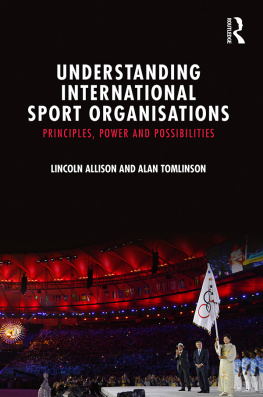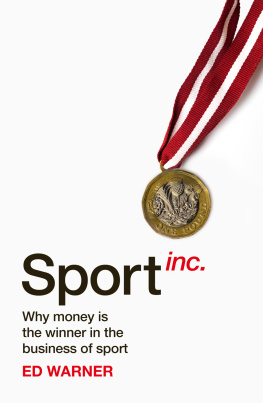GLOBALIZING SPORT
GLOBALIZING SPORT
HOW ORGANIZATIONS, CORPORATIONS, MEDIA, AND POLITICS ARE CHANGING SPORTS
GEORGE H. SAGE
First published 2010 by Paradigm Publishers
Published 2016 by Routledge
2 Park Square, Milton Park, Abingdon, Oxon OX14 4RN
711 Third Avenue, New York, NY 10017, USA
Routledge is an imprint of the Taylor & Francis Group, an informa business
Copyright 2010, Taylor & Francis.
All rights reserved. No part of this book may be reprinted or reproduced or utilised in any form or by any electronic, mechanical, or other means, now known or hereafter invented, including photocopying and recording, or in any information storage or retrieval system, without permission in writing from the publishers.
Notice:
Product or corporate names may be trademarks or registered trademarks, and are used only for identification and explanation without intent to infringe.
Library of Congress Cataloging-in-Publication Data
Sage, George Harvey.
Globalizing sport : how organizations, corporations, media, and politics are changing sports / George H. Sage.
p. cm.
Includes bibliographical references and index.
ISBN 978-1-59451-757-0 (hardcover : alk. paper)
ISBN 978-1-59451-758-7 (pbk. : alk. paper)
1. Sports and globalization. 2. SportsSociological aspects. I. Title.
GV706.34.S34 2010
306.483dc22
2010015958
Designed and Typeset by Straight Creek Bookmakers.
ISBN 13 : 978-1-59451-757-0 (hbk)
ISBN 13 : 978-1-59451-758-7 (pbk)
Dedicated to Liz
the brightest star in my personal universe
I want to explain four important features about this book. First, this book is about global sport. It is not an encyclopedic treatment of global sport. That would require a sprawling, multivolume undertaking. It would also require a writer fluent in at least several languages in order to be knowledgeable about relevant global sports topics in the major non-English languages of the world.
Second, although most regions of the world are given some attention in each chapter of this book, North America and Europeincluding the United Kingdomreceive the most. An abundance of literature is available about sport in the nations of these regions, and media coverage of international sports is overwhelming focused on them.
Third, most books published on the topic of global sport are written for readers who are either upper-level undergraduate students or graduate students in sport studies. These books tend to be descriptions of research findings or interpretations and analyses of research on global sport topics. This is reflected in the fact that several of them are edited books, so they are typically not meant to be read from cover to cover but to serve readers who have a particular research interest in one or two of a books chapters.
Fourth, my goal in writing this book is to provide readers new to the subject of global sports with an understanding of the fields issues and trends. The book is intended for the general reader who is interested in the international sport world but has never come across a book that deals with this subject. It is also directed to college students who may be studying sociology, sport studies, political science, international relations, geography, history, or the like, and have not encountered a book with a focus on global sport. Finally, faculty who wish to supplement their regular course textbook may find a volume devoted to global sport a good addition.
Sport, a seemingly trivial facet of life, is a fundamental cultural activity in every country of the modern world. In short, global sport transcends national boundaries, and it is both a product of and a contributor to the processes of globalization. In various ways sport is a microcosm of worldwide political, economic, and cultural trends. Thus, you have global sport embroiled in international political issues; transnational corporations marketing sport through the production of global sporting events, such as the Olympic Games and World Cup; athletes migrating to various countries seeking the best salaries and benefits; sporting goods and equipment, essential products for sports, manufacturing in low-wage countries.
Perhaps as much as anything else, global sport is big business. Television networks bid billions of dollars for the rights to televise international sporting events. The new medium of the Internet and its various spin-offs have found sport at the cutting edge of global mass communications. Globally elite athletes, such as soccers David Beckham and Cristiano Ronaldo, as well as others, command multiyear, multi-million-dollar contracts. Global sport icons, like Phil Mickelson and LaBron James, make more money through product endorsements than they do from their sports achievements. Global sport organizations have some of the same characteristics as transnational corporations, with their business in the management and production of sporting events throughout the world.
In writing a book like this, one must rely on the research and writings of others, and the friendship of colleagues helps too. I am indebted to numerous scholars of global sport, many of whom are personal friends. Their good work has been of invaluable assistance to me in preparing this book. Beyond that, I want to express my profound appreciation to longtime colleagues in sport sociology, D. Stanley Eitzen and John W. Loy, for the intellectual inspiration, encouragement, and continued friendship they have provided me over the years.
With the publication of this volume, my name now appears on twenty books (counting multiple editions), either as author, coauthor, or editor. I dedicated my first book to my wife, Liz. The books that followed were dedicated to other members of my extended family. Now, with this twentieth book, I return to the one who has always been there for me, has good-naturedly always granted time for me to write, has been my greatest supporter, and has been my best friend and the love of my lifeLiz.
THE TRANSFORMATION FROM LOCAL TO NATIONAL TO GLOBAL
Sport has become a major actor in modern society and is present everywhere. This phenomenon has spread with our world becoming more and more global.
Global Sports Forum, Barcelona, Spain, 2008
In the midst of writing this book, I had lunch with a friend whom I had not seen for several months. At one point during our luncheon conversation, my friend asked what I had been doing. When I replied that I was writing a book about global sport, he asked, What does sport have to do with global? Having written some 20,000 words on the subject at that point, I wondered how I was going to answer his question with an appropriately brief synopsis. I decided to use a few vignettes that would, hopefully, help him understand the connections between global and sport. After I had articulated five or six global-sport connections, my friend said, Enough, okay, I get it.














